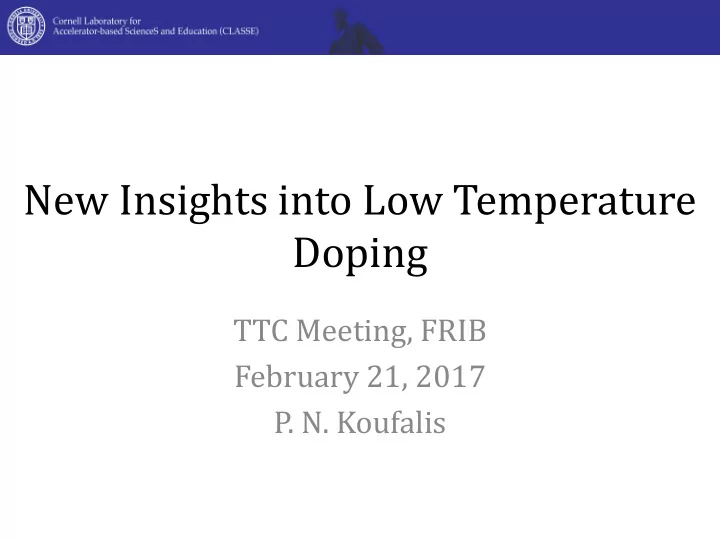

New Insights into Low Temperature Doping TTC Meeting, FRIB February 21, 2017 P. N. Koufalis
Motivation • In high temperature doping (~800 – 1000 o C) nitrogen diffuses several microns into the niobium lattice in a matter of minutes • Reduces electron mea ean fr free ee pa path th in the RF penetration layer • Results in anti anti- Q -slope and hi higher Q 0 values • Requires po post-tr treatment t 1.3 GHz single-cell cavities che chemistry to remove lossy N-doped nitride layer and typically results in lo lower r que quench fie fields in strongly doped cavities EP + 900 o C T = 2.0 K A. Grassellino et al., Supercond. Sci. Tech. 26 26 (2013).
Motivation • It has been shown that low temperature baking (~160 o C) in a nitrogen atmosphere also results in anti anti- Q -slope and hi higher Q 0 A. Grassellino and S. Aderhold, New low T nitrogen treatments: cavity results with record gradients and Q. TTC, Saclay. 2016. • In this temperature regime, nitrogen should not diffuse more than a a few nm into the niobium! • What is going on? Why are the sa same ef effects ts observed?
Cavit ity Preparation • 1.3 GHz single cell TESLA- shaped cavity • Che hemistry: • BCP (in + out) • EP (16 μ m; in) • Lo Low tem emperatu ture ba bake: • 800 o C (10 hr; UHV) • 160 o C (48 hr; N 2 ) • 160 o C (168 hr; UHV) Conti tinuously flo flowing nit itrogen atm atmosphere!
Cavit ity Performance • 160 o C cavity: • Anti ti- Q -slope • Hig igher Q 0 • Similar performance compared to nitrogen- doped (800 o C) cavities T = 2.0 K • Im Implie ies im impurit ities! • Quench at E acc = 25 MV/m (B pk ~ 107 mT) Max ax Qu Quality ty Factor: Q 0 = 3.6 .6 × 10 10 10 10 @ 16 MV/m
Cavit ity Performance • Reduction of the BCS su surface resistance with increasing gradients leads to anti anti- Q -slope • Sa Same ef effect seen in (800 o C)N-doped cavities • Should see similar mean free path • What is the impurity?
Sample Analysis Oxide layer N-doped + • Sample analyzed with O 10 μ m EP secondary ion mass C spectroscopy (SIMS) • If nit nitrogen is responsible N for reduction of mean free path, then should observe similar concentrations RF layer compared to the N- doped sam do ample le • However, the ni nitr trogen co concentratio ion is much • N N concentratio ion @ 5 nm nm: : ~3.6 × 10 19 atoms/cm 3 lower than the N-doped sample in the RF layer • N N concentratio ion @ 50 nm nm: < 1 × 10 19 atoms/cm 3
Sample Analysis Oxide layer N-doped + • The ca carbon and oxygen O 10 μ m EP concentration is much C higher than that of nitr ni troge gen! N • If mean free path is responsible for the observed effects, then C and O must be RF layer responsible • C C an and O O concentratio ion @ 5 nm nm: : ~10 21 atoms/cm 3 • C C and nd O concentratio ion @ 50 nm nm: : ~5 × 10 20 atoms/cm 3
Sample Comparis ison EP + No Bake 160 o C • Near identical N concentration • The difference between the samples is the C and O concentration in the RF layer!
Sources of C and O? • The nitrogen supplied during the ‘doping’ step is co continuously flo flowing and is supplied from li liquid nit itrogen blo blow-off • Impurity content includes < 5 ppm ppm O 2 , < 3 pp ppm H 2 O, and < 1 pp ppm CO, , CO 2 , , tot otal hydrocarbons • Possible source of C and O • Surface carbon/carbides? • Furnace contamination? • Backflow from furnace pumps
Dif iffusion Model • Fick’s second law: 𝜖𝑑 𝜖𝑢 = 𝐸 𝜖 2 𝑑 𝜖𝑦 2 𝑑 = impurity concentration 𝑦 = depth into material 𝑢 = time 𝐸 = diffusion coefficient • Solution: 𝑑 𝑦, 𝑢 = 𝐷 ′ + 𝐷 ′′ − 𝐷 ′ erfc 𝑦 𝐸𝑢 𝐷 ′ = initial impurity concentration in bulk 𝐷 ′′ = impurity concentration at the surface
Material l Properties • RF measurements and BCS prediction: l = 7.04 nm • Very short measured mean free path: l ≈ 7 nm!
Material l Properties • At l = 7 nm penetration depth ~100 nm • Use depth of 50 nm to calculate mean free path estimate: ∆𝝇 = = resis istivit ity 𝒃 = 4.3 .3 × 10 10 -8 Ω∙ m (C (C, , O) ∆𝜍 = 𝑏 ∙ 𝑑′ 𝒃 = 5.2 .2 × 10 10 -8 Ω∙ m m (N (N) 𝒅′ = impurit ity concentratio ion • Mean free path is related to the change in resistivity by: 𝜏 𝑚 = ∆𝜍 𝝉 = 0.3 .37 × 10 10 -15 15 Ω∙ m 2 MF MFP @ de depth = 50 50 nm nm Carbon + Oxygen 5 nm Nitrogen Only 712 nm • Even at the RF surface (5 nm) the resulting mean free path estimate due to only nitrogen is: 110 nm nm!
Concluding Remarks • For low T baking, C C and O play the dominant role in the reduction of the mean free path • At 160 o C, nit itrogen does not diffuse whereas oxygen and ca carbon diffuse readily • RF measurements of mean free path consistent with theoretical calculations based on measured impurity concentrations • Low temperature treatment results in the same effects: • anti anti- Q -slope and im improved Q 0 0 • No post-treatment EP needed
Concluding Remarks THANK YOU FOR YOUR ATTENTION!
Recommend
More recommend